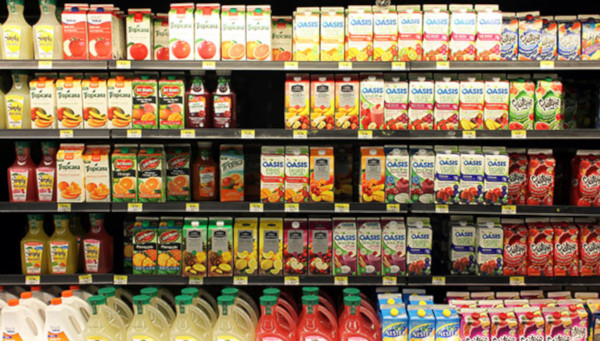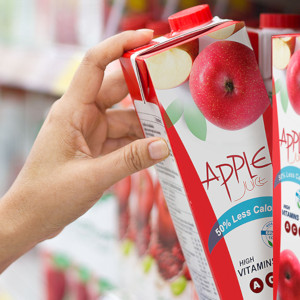Sugary beverages have been increasingly condemned as a primary cause of obesity – especially in youngsters and teens – over the past few years. But the latest comprehensive report on the issue reveals that beverage makers have not cut back significantly on marketing sugary drinks to kids…
 Dozens of Brands, hundreds of varieties: ‘Healthy’, ‘Juice’ drinks for kids.
Dozens of Brands, hundreds of varieties: ‘Healthy’, ‘Juice’ drinks for kids.
Healthier than Soft Drinks / Soda? But what’s really in them?
We’re not talking Soft Drinks / Sodas as such, here. They constitute a whole separate category of beverage. What we’re talking about, primarily, is Fruit ‘Juices’, Fruit ‘Drinks’ and Flavoured Waters, which kids and parents generally consider healthier than fizzy beverages. But the truth is, many of those contain just as much added Sugar as Soft Drinks. And the beverage industry is still making major efforts to hide, or minimize the impact of, the nutrition facts about its products…
Follow the FACTS
The new revelations about Sugary Drinks marketed primarily to kids in the U.S. are contained in the 2019 Children’s Drink FACTS Report from the University of Connecticut Rudd Center For Food Policy and Obesity. ‘FACTS’ stands for ‘Food Advertising to Children and Teens Score’, and the industry scored pretty low on transparency. The following facts are from the official Summary of the Report:
Nutrition Facts
Sweetened Fruit drinks and Flavored Waters
- 65 percent contained added Sugars and 74 per cent contained low-calorie sweeteners; 38 percent contained both types of sweeteners.
- Two-thirds did not contain any Juice, and the majority of products with Juice contained just 5 percent.
- One serving of many of the highest-selling Fruit Drink brands (such as Capri Sun Juice Drink, Hawaiian Punch, Sunny D, and Minute Maid Lemonade) had more than 50 percent of the recommended amount of daily added sugars for children (i.e., >12.5g) [per serving].
- Due to the added sugars and low-calorie sweeteners in sweetened children’s drinks, none of them met expert recommendations for drinks that should be served to children under 14 years old.
100 percent Juice and Juice/Water blends
- The nutrition content of 100 percent Juice products did not vary widely (total sugar of 3-4 g/oz.) as the only ingredients were Fruit Juice or Fruit Juice concentrate and water.
- Most 100 percent juice products that came in single-serving boxes or pouches contained more than 4 ounces, which is the maximum recommended daily amount of juice for toddlers (1-3 years).
- Some Juice boxes and pouches contained more than 6 ounces of Juice, the maximum daily amount recommended for preschoolers (4-6 years).
- Juice/Water blend products were the healthiest children’s drinks. They consisted of Juice and Water with no added Sugars or low-calorie sweeteners, and they were lower in calories and total sugars than 100 percent juice.
Marketing Facts
Similar claims and branding on packages of sweetened children’s drinks and drinks without added sweeteners may confuse consumers about the ingredients in these drinks.
- Images of fruit appeared on 85% of children’s sweetened drink packages (regardless of whether the product contained any fruit juice); claims about lowsugar content and Vitamin C were also prevalent.
- Brands that offered both sweetened drinks and drinks without added sweeteners (including Apple & Eve, Capri Sun, and Mott’s) used similar-looking packages, flavor names, fruit images, and claims for all their products
- Information about percent juice (with the exception of 100% juice) and types of sweeteners contained in children’s drink products were only available on the nutrition facts panel on the back of the package.
Sweetened children’s Drink brands continue to advertise directly to children
- Sweetened children’s Drink [brands] spent more to advertise on TV than children’s Drinks without added sweeteners ($18.5 vs. $13.6 million).
- Kraft Heinz advertised two sweetened Drinks – Kool-Aid Jammers and Capri Sun Roarin’ Waters – directly to children on children’s TV programming.
- According to the Children’s Food & Beverage Advertising Initiative industry self-regulatory program, these Drinks are exempt from meeting nutrition standards for products that can be advertised in child-directed media because they have less than 30 calories. However, they contained both added Sugars and low-calorie sweeteners.
Recommendations
Improvements in the marketing of children’s drinks would help parents identify healthier children’s Drinks and reduce Sugary Drink consumption by children:
- Beverage manufacturers should clearly indicate on the front of children’s Drink packages that a product contains added Sugars and/or low-calorie sweeteners and the percent Juice content.
- The U.S. Food and Drug Administration could require that products with nutrition-related claims on packages meet minimum nutrition standards and prohibit the use of Fruit and Vegetable images on Drink product packages that contain little or no Juice.
- The Children’s Food and Beverage Advertising Initiative should establish nutrition standards that align with health expert recommendations. Specifically, Drinks with added Sugars and/or low-calorie sweeteners should not be advertised directly to children.
- All media companies should follow the lead of Disney and Sesame Street and set nutrition standards for products than can license their characters on products for children.
- State and local governments should increase the price of Sugary Drinks, including Fruit Drinks and flavored Waters, through an excise tax.
My take
I was aghast to see the nefarious shennigans that children’s Drink makers were up to, in their labelling, their claims and their advertising. It just goes to show you how regulations can be worked around and shoved to the back of the cupboard (so to speak) when big bucks are at stake. And make no mistake; the money is what it’s all about. Even if the makers do feel they have to stretch the truth to get kids and parents to buy the products.
Just to be safe… Go with your doctor’s recommendations about what kind of Drinks to serve your kids. And remember the primary recommendation for all age groups and backgrounds: Consider Water first!
~ Maggie J.

